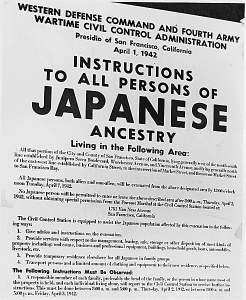
Instructions for Japanese American 1942
77 years ago on February 19th 1942, Executive Order 9066 was issued. The Order directed the army to create military zones and to remove all residents of Japanese ancestry during World War II. It also created the War Relocation Authority which forcibly relocated over 110,000 citizens to internment camps. Last week,, the president declared a State of Emergency in order to get funding for the wall along the Southern US border with Mexico. Although there are over 30 emergency declarations in place at present, Trump’s action is unprecedented.
There were only two times that the Executive branch has taken money from the military under a State of Emergency. The first was when George H W Bush began the Gulf War and then with his son George W Bush after September 11th 2001. Both times the presidents had used military money for military purposes for facing a perceived external threat.
There are no restrictions to what could constitute an emergency but it appears that this is the first time a president has appropriated money which according to the US constitution, is a power of Congress. Trump is attempting to seize over $8 billion to expand a wall over 2,000 miles. It appears that a large majority of the money to fund the wall is being diverted from military construction projects. Many of the projects potentially targeted could also come from the fund for Overseas Contingency Operations (OCO), the so called “war budget” that funds the wars in Iraq and Afghanistan, according to congressional aids. According to Military.com, Trump could have as much as $21 billion in “unobligated” funds from military construction projects going back 5 years. Although it appeared that the White House was going to limit itself to $11.8 billion for the wall.
Just two days before the State of Emergency was announced, the Senate Armed Services subcommittee held a hearing on the deplorable living conditions on military bases. At the hearing black mold and lead paint were among the complaints in Trump Declares National Emergency in ‘Slap in the Face to Military Families’ Many in the military were aghast at the taking of money designated for infrastructure. The president wants to militarize the border while leaving military bases in disrepair. Concerning the base projects, Trump stated “It didn’t sound too important to me.”
While there have been States of Emergencies in the past, we are definitely in uncharted territory. One of the major challenges of the State of Emergency declaration is that there is no regulation of what constitutes an Emergency and when it will be over. Once a State of Emergency Order is signed, the president has 100 provisions available to them including shutting down electronic communication (email, websites and voter information) and seizing bank accounts and passports. This may sound familiar to War Tax Resisters.
During World War II, the Executive Order of relocating Japanese Americans to internment camps was heard before the US Supreme Court. Ultimately the Court ruled that the Order was constitutional in Korematsu v US. One of the dissenting justice’s opinion seems important today in regards to Executive overreach. ”…the Court for all time has validated the principle of racial discrimination in criminal procedure and of transplanting American citizens. The principle then lies about like a weapon ready for the hand of any authority that can bring forward a plausible claim of an urgent need.”
While there has been much discussion about what constitutes a “state of emergency,” Trump’s rationale is based upon fear and not facts. It is a dangerous path to take the nation down. Fortunately people are not buying into the fear and the resistance is growing.
Post by Chrissy Kirchhoefer

Thanks for this post, Chrissy, it’s really important stuff!
Thanks Erica!